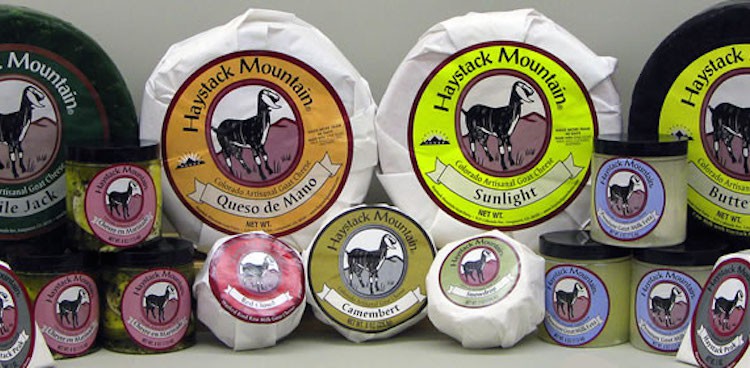
If there’s anything that Haystack Creamery in Longmont, Colo. knows how to do (besides making delicious cheese), it’s how to work with what they’ve got.
“We’ve had to get really creative working with spaces over the years,” John Scaggs, Director of Sales and Marketing, says. “The cheese room itself is pretty funky.”
According to Scaggs, Haystack Creamery purchased a vat from Sid Cook of Carr Valley back in the 90’s that they continue to use for cheesemaking. They also bought an old spice grinder at a coffee repair shop in Denver. “That’s what we use to grind herbs for chèvre,” Scaggs explains. “It gives the herbs a bright, clean flavor … and saves us money.”
The source of their milk, too, may come as a surprise. The milk is produced by goats, but processed by inmates at Colorado Correctional Industries, or CCI. Back when Haystack Creamery began in 1989, they searched for a milk producer.
“Colorado doesn’t have the dairy culture that the Northeast does,” Scaggs says. “We had a few small farms that we worked with, but then we heard the CCI had a dairy farm.” Haystack’s founder Jim Schott sold his herd of goats to CCI and worked hand-in-hand with them in developing a parlor and pens. According to Scaggs, CCI and its inmates are a separate entity from Haystack.
“They produce high-quality milk consistently,” Scaggs says of CCI. He adds that though many of the inmates pursue a career in agriculture after their release, the majority of them become involved in an industry that is tangentially related to dairy, such as refrigeration or electric. The program gives them a new skill-set through hands-on experience. Many of the prisoners become deeply involved in the dairy industry while completing the program.
“I took the whole staff to CCI’s birthing pen and nursery and hung around there for two hours with the inmates,” Scaggs says, “They were going on and on about goats and I could see their faces lighting up. If that’s where I have to go to prison, you can lock me up and throw away the key.”
Haystack Creamery not only engages prisoners to become involved with dairy culture, but the entire surrounding community. Located in downtown Longmont and nestled between the Rocky Mountains, Haystack is known for a deep involvement with local farmers’ markets. “Farmers’ markets are the lifeblood of our company,” Scaggs explains, adding that that Jim Schott sold Haystack’s first cheese at the Boulder County Farmer’s Market back in 1991.
Not much has changed in terms of Haystack’s commitment to local farmers’ markets, but there has been a massive amount of growth in terms of Haystack’s distribution, production, and variety of cheeses. In 1989, there were five goats on Jim Schott’s five-acre farm, and Haystack was producing fresh, creamy, and simple chèvre. In 2003, Haystack outgrew their facility and purchased a 2500-square-foot creamery that they expanded upon in 2005. Head cheesemaker Jackie Chang experimented with different cheeses, first with herb-coated chevres, then with aged raw-milk cheeses (such as Snowdrop and Haystack Peak), aged washed rind cheeses (such as Red Cloud), a mixed goat and cow’s milk cheese, and a cow’s milk alpine-style cheese, among others.
“We’ve been trying to find new ways to keep our cheese room busy and developed some amazing cheeses in the process,” Scaggs says, adding that his personal favorite is the Wall Street Gold, named after a Boulder mine that was the source of gold in the late 1880s. Like the gold found there, this cheese has a beautiful golden color.





